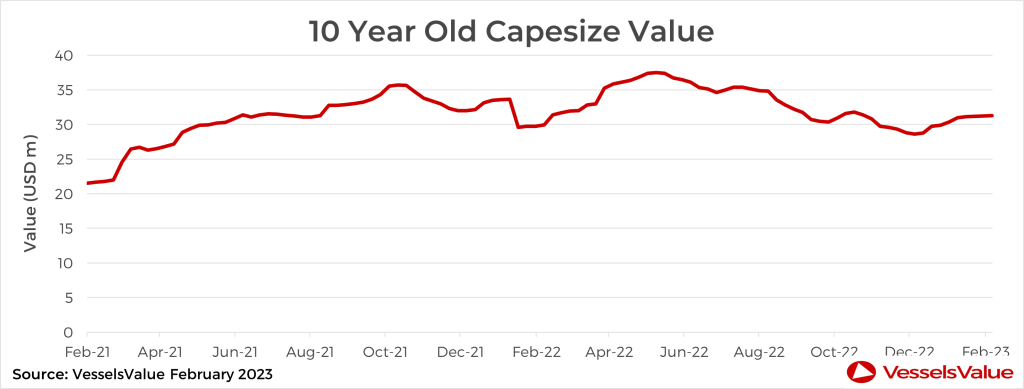Market Chat: What’s Causing Capesize Values to Drop?
What’s the story with Capesizes?
Capesize earnings have fallen to the lowest levels since Q1 2020. Although we have come to expect a seasonal lull during the first quarter of the year, with the Lunar New Year celebrations now a distant memory, what is causing rates to fall further?
Bulker market players take into account that each year, Q1 will be the weakest quarter for earnings, and this is usually due to a number of seasonal factors. The most notable is of course, the annual Lunar New Year celebrations. Prior to the holiday period this year, there was hope that the relaxation in Covid-19 regulations in China would result in an uptick in Bulker demand. However, the resurgence of the nation’s construction industry is also eagerly awaited, with expectation that further stimulus measures could be announced at the annual parliament meeting in March. Furthermore, these measures could provide support to iron ore, and therefore Capesize demand going forward.
December to March also denotes the rainy season in Brazil, and heavy rainfall often disrupts iron ore operations at this time of year. In a recent statement, Brazilian miner Vale blamed seasonally higher rainfall levels in mining regions for lower than expected production levels, causing them to miss forecasts. This has caused disruption to export levels in the short term and resulted in an oversupply of ships in the area, putting additional pressure on Capesize rates which have fallen to 2,513 USD/Day, a decrease of c.84% YoY.
Supporting Bulker demand going forward is the news that China has started to buy Australian coal once again, following an embargo. Although trade is unlikely to revert to pre pandemic levels due to rerouting, and increased exports from Australia to China is welcoming news for Capesize tonne mile demand.
The sale and purchase sector is far more optimistic in stark contrast to earnings, with 16 secondhand sales reported so far this year compared to 12 in the same period last year, an increase of c.33% YoY. This is supported by recent sales transactions, and benchmark values for Capes have increased across all age categories. For example, values for 10 year old Capesizes of 180,000 DWT have increased c.5% from the start of the year from USD 29.72 mil to USD 31.18 mil. Values have come down from the 12 year highs of c. USD 37 mil seen in 2022, but remain firm.
Notable sales include Golden Ocean’s acquisition of six Chinese built Newcastlemax vessels (208,000 DWT, build year 2017 to 2021), all with 36 month TC back (USD 21,000/day) in an En bloc deal with H Line worth USD 291 mil, VV Value USD 279.3 mil. Also, the Ocean Caesar (180,200 DWT, Jun 2008, Imabari) that sold to Winning Shipping for USD 19.70 mil, VV value USD 20.87 mil.

Greece offloading older Tankers
Tempted by surging prices, Tanker sales from Greek owners have increased so far this year. There have been 29 Tanker sales, compared to just 12 for the same period last year, an increase of 141% YoY.
The average age of vessels sold is 16 years, as owners take advantage of the continued high values for vintage Tankers. For example, values for LR1 Tankers have seen the most impressive gains, driven by surging rates which received a boost since the introduction of sanctions on Russian petroleum products in early February. Values for 20 year old vessels of 70,000 DWT have shot up by c.8% from the start of the year from USD 15.22 mil to USD 16.49 mil.
Tanker sales by Greek owners have been reported across all categories, but the most popular size range has been Handy Tankers, with eight sales, followed by Afras with seven sales, and Panamaxes ranking third with six sales.
Notable sales include the Nave Photon (297,400 DWT, Oct 2008, Jiangnan Shanghai Changxin HI) that sold to Singapore based Wirana Shipping for USD 58 mil, VV value USD 53.98 mil.
Disclaimer: The purpose of this blog is to provide general information and not to provide advice or guidance in relation to particular circumstances. Readers should not make decisions in reliance on any statement or opinion contained in this blog.
Want to know more about how our
data can help you assess the market?

